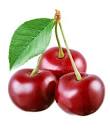 A cherry is the fruit of many plants of the genus Prunus, and is a stone fruit.
A cherry is the fruit of many plants of the genus Prunus, and is a stone fruit.
Cherry is a fruit that grows on trees of the genus Prunus.
It is round or slightly heart-shaped, with a smooth, glossy skin that ranges in color from bright red to deep purple-black.
Cherries are known for their juicy, sweet, and slightly tart taste, and are often used in sweets, desserts, and baked goods.
There are two main types of cherries: sweet and sour.
Sweet cherries are eaten fresh, while sour cherries are mainly used for cooking and are commonly used in making pies, preserves, and jams.
Cherries are rich in antioxidants and vitamin C, and can help reduce inflammation and lower the risk of chronic diseases such as cancer, heart disease, and diabetes.
Cherries are in season from May to August in the United States, and are widely available in supermarkets and farmer’s markets.
A cherry tree will take three to four years once it is planted in the orchard to produce its first crop of fruit.
A cherry tree takes seven years to attain full maturity.
Cherry trees require a certain number of chilling hours each year to break dormancy and bloom and produce fruit.
The cherry can be a difficult fruit tree to grow and keep alive.
Most cherry varieties have a chilling requirement of 800 or more hours, below 45 °F (7 °C).
Low chill varieties requiring 300 hours or less extend the range of cultivation of cherries to the mild winter areas of southern US.
Raw sweet cherries are 82% water, 16% carbohydrates, 1% protein, and negligible in fat.
Sweet cherries provide little nutrient content per 100 g serving, as only dietary fiber and vitamin C are present in moderate content, while other vitamins and dietary minerals each supply less than 10% of the Daily Value (DV) per serving, respectively,
Compared to sweet cherries, raw sour cherries contain 50% more vitamin C per 100 g (12% DV) and about 20 times more vitamin A (8% DV), beta-Carotene in particular.
Nutritional value per 100 g (3.5 oz)
Energy 209 kJ (50 kcal)
Carbohydrates
12.2 g
Sugars 8.5 g
Dietary fiber 1.6 g
Fat 0.3 g
Protein 1 g
Vitamins Quantity %DV†
Vitamin A equiv. 8% 64 μg
beta-Carotene 7%770 μg
lutein zeaxanthin 85 μg
Thiamine (B1) 3% 0.03 mg
Riboflavin (B2) 3% 0.04 mg
Niacin (B3) 3% 0.4 mg
Pantothenic acid (B5) 3% 0.143 mg
Vitamin B6 3% 0.044 mg
Folate (B9) 2% 8 μg
Choline 1% 6.1 mg
Vitamin C 12% 10 mg
Vitamin K 2% 2.1 μg
Minerals Quantity %DV†
Calcium 2% 16 mg
Iron 2% 0.32 mg
Magnesium 3% 9 mg
Manganese 5% 0.112 mg
Phosphorus 2% 15 mg
Potassium 4% 173 mg
Sodium 0% 3 mg
Zinc 1% 0.1 mg
Other constituents Quantity
Water 86 g
Nutritional value per 100 g (3.5 oz)
Energy 263 kJ (63 kcal)
Carbohydrates 16 g
Sugars 12.8 g
Dietary fiber 2.1 g
Fat 0.2 g
Protein1.1 g
Vitamins Quantity %DV†
Vitamin A equiv. 0% 3 μg
beta-Carotene 0%38 μg
lutein zeaxanthin 85 μg
Thiamine (B1) 2% 0.027 mg
Riboflavin (B2) 3% 0.033 mg
Niacin (B3) 1% 0.154 mg
Pantothenic acid (B5) 4% 0.199 mg
Vitamin B6 4% 0.049 mg
Folate (B9) 1% 4 μg
Choline 1% 6.1 mg
Vitamin C 8% 7 mg
Vitamin K 2% 2.1 μg
Minerals Quantity %DV†
Calcium 1% 13 mg
Iron 3% 0.36 mg
Magnesium 3% 11 mg
Manganese 3% 0.07 mg
Phosphorus 3% 21 mg
Potassium 5% 222 mg
Sodium 0% 0 mg
Zinc 1% 0.07 mg
Water 82 g
The cherry kernels, accessible by chewing or breaking the hard-shelled cherry pits, contain amygdalin, a chemical that releases the toxic compound hydrogen cyanide when ingested.
The amount of amygdalin in each cherry varies.
Toxicity symptoms would show only after eating several crushed pits.
Swallowing the pits whole normally causes no complications.
A normal cherry pit contains 0.004 mg of cyanide, which is not a fatal dose for humans, but is best avoided, as different varieties of cherries may contain higher amounts of cyanide.
Cherry products have antioxidant and anti-inflammatory (IL-6, TNF-α, IL-1β, IL-8, COX-I and -II) properties, hypouricemic effects, and the ability to downregulate NFkB-mediated osteoclastogenesis, and may reduce both the acute and chronic inflammation associated with recurrent gout flares and its chronic destructive arthropathy.
